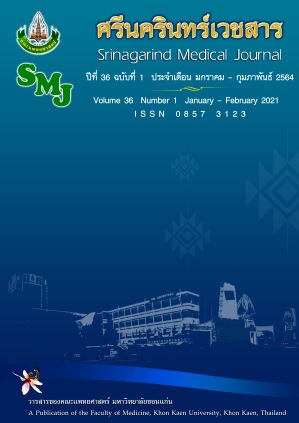Antihypertensive and Antioxidative Effects of Asiatic Acid in Rats with Long-Term Exposure to Cadmium
Abstract
ผลต้านภาวะความดันเลือดสูงและภาวะเครียดออกซิเดชันของกรดอะเซียติกในหนูแรทที่ได้รับแคดเมียมเป็นระยะเวลานาน
อัครชัย ทับสกุล 1, วีระพล แสงอาทิตย์ 1, พวงรัตน์ ภักดีโชติ 1, วีรพล คู่คงวิริยพันธุ์ 2, ยุพา คู่คงวิริยพันธุ์1,*
1 ภาควิชาสรีรวิทยา, คณะแพทยศาสตร์ มหาวิทยาลัยขอนแก่น
2 ภาควิชาเภสัชวิทยา คณะแพทยศาสตร์ มหาวิทยาลัยขอนแก่น จังหวัดขอนแก่น 40002 ประเทศไทย
หลักการและวัตถุประสงค์: แคดเมียม (Cd) เป็นโลหะหนักที่มีพิษชนิดหนึ่งที่ก่อให้เกิดการทำลายเนื้อเยื่อต่างๆที่เกิดจากออกซิเดชันและเกี่ยวข้องกับภาวะความดันเลือดสูง สารต้านออกซิเดชันถูกนำมาใช้เพื่อต่อต้านพิษที่เกิดขึ้นจาก Cd กรดอะเซียติก (AA) คือสารเพนทะไซคลิกไทรเทอร์พีนอยด์ที่สกัดได้จากต้นบัวบก (Centella asiatica) และมีฤทธิ์ต้านออกซิเดชัน การศึกษานี้มีวัตถุประสงค์เพื่อสำรวจว่า AA สามารถลดภาวะความดันเลือดสูงและภาวะเครียดออกซิเดชันในหนูแรทที่ได้รับ Cd เป็นเวลานาน
วิธีการศึกษา: หนูแรท เพศผู้ พันธุ์ Sprague-Dawley ได้รับ Cd ทุกวัน ผ่านทางน้ำดื่มที่ประกอบด้วยแคดเมียมคลอไรด์ 10 พีพีเอ็ม เป็นเวลา 16 สัปดาห์ หนูแรทในกลุ่มควบคุมจะได้รับน้ำกรองเป็นน้ำดื่ม หนูแรทถูกป้อนด้วย AA (15 หรือ 30 มก./กก.) วันละครั้งในช่วง 4 สัปดาห์สุดท้ายของการทดลอง
ผลการศึกษา: Cd เหนี่ยวนำให้เกิดภาวะความดันเลือดสูงในหนูแรทโดยการเพิ่มความดันเลือดของหลอดเลือดแดงและเพิ่มความต้านทานการไหลเวียนเลือดส่วนปลาย Cd ลดการขยายตัวของหลอดเลือดที่ตอบสนองต่อยาขยายหลอดเลือดอะซิติลโคลีน (p < 0.05) ในขณะที่การตอบสนองต่อยาขยายหลอดเลือดโซเดียมไนโตรปรัสไซด์ไม่เปลี่ยนแปลง AA ให้ผลตามระดับความเข้มข้นในการปรับพลศาสตร์การไหลเวียนเลือดให้ดีขึ้นและเพิ่มการตอบสนองของเซลล์เอนโดทีเลียมอย่างมีนัยสำคัญทางสถิติ (p < 0.05) AA ลดภาวะเครียดออกซิเดชัน เพิ่มกลูตาไธโอนในเลือด และเพิ่มระดับไนเตรท/ไนไตรท์ในพลาสมา นอกจากนี้ AA ยังช่วยลดการสะสม Cd ในเลือดและในเนื้อเยื่อหลอดเลือดด้วย
สรุป: ผลการศึกษาเหล่านี้บ่งชี้ว่า AA อาจเป็นสารต้านออกซิเดชันที่ช่วยป้องกันภาวะความดันเลือดสูง ภาวะเอนโดทีเลียมทำงานผิดปกติและภาวะเครียดออกซิเดชันที่เหนี่ยวนำโดย Cd
คำสำคัญ: กรดอะเซียติก; แคดเมียม; ความดันเลือดสูง; ไนตริกออกไซด์; ภาวะเครียดออกซิเดชัน
Background and objective: Cadmium (Cd) is a toxic heavy metal which causes oxidative damage to various tissues and associated with hypertension. Antioxidants have been used to protect against Cd intoxication. Asiatic acid (AA) is a pentacyclic triterpenoid extracted from Bua-Bok (Centella asiatica) and possesses strong antioxidant activities. This study aimed to investigate whether AA could attenuate hypertension and oxidative stress in rats chronically exposed to Cd.
Methods: Male Sprague-Dawley rats were exposed to Cd daily via consumption of water containing 10 ppm cadmium chloride for 16 weeks. Rats in the control groups received deionized water as drinking water. AA (15 or 30 mg/kg b.w.) was orally administered once daily for the last 4 weeks of the experiment.
Results: Cd induced hypertension in rats by increasing arterial blood pressure and peripheral vascular resistance. Cd significantly attenuated the vasodilating responses to acetylcholine (p < 0.05) while the vasodilating responses to sodium nitroprusside were unchanged. AA in a dose dependent manner significantly improved hemodynamics and increased endothelial-dependent responses (p < 0.05). AA alleviated oxidative stress, enhanced blood glutathione and increased plasma nitrate/nitrite level. Moreover, AA also reduced the accumulation of Cd in blood and vascular tissues.
Conclusions: These results suggest that AA is a protective antioxidant against Cd-induced hypertension, endothelial dysfunction and oxidative stress.
Keywords: Asiatic acid; Cadmium; Hypertension; Nitric oxide; Oxidative stress


